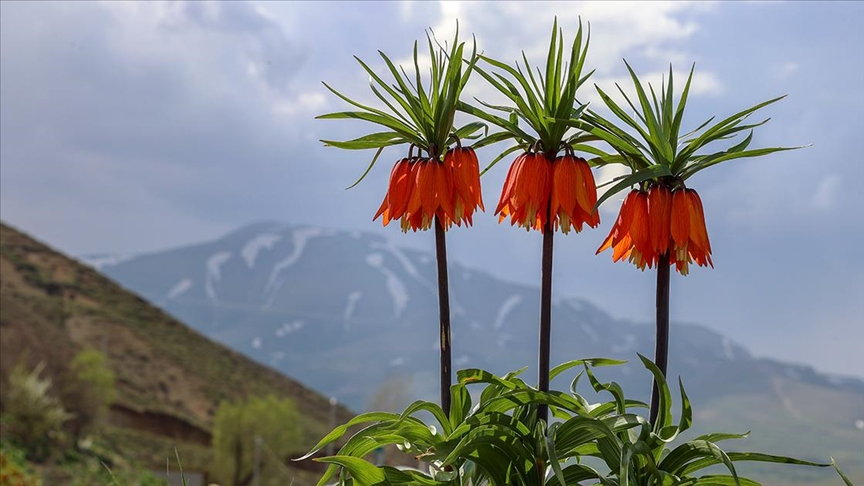The inverted tulip ( Fritillaria) is a perennial, bulbous, herbaceous plant belonging to the lily family (Liliaceae). Known for its bell-shaped flowers, this plant symbolizes the arrival of spring in Anatolia.
Morphological Features
The inverted tulip ( Fritillaria ) is a perennial bulbous plant in the Liliaceae family. It gets its name from its tendency to droop downward, unlike the tulip's upright habit. This morphological feature is also known as "weeping bride" or "weeping tulip ." This herbaceous plant's height varies depending on the species, but generally grows between 60 and 80 centimeters; some species reach up to 75 cm. Each branch on the plant's stem typically bears six bell-shaped flowers, each growing inverted and hanging down. Just above this cluster of flowers, which droop downward, is a crown-like cluster of leaves at the top of the plant. Inverted tulips can bloom in various shades, including yellow, purple, brown, green, and red. While checkerboard patterns or markings can sometimes be seen on these flowers, the wild forms are predominantly orange or red.

Inverted Tulips ( Anadolu Ajansı)
Distribution and Habitat
Fritillaria ( Fritillaria ) are perennial bulbous plants that grow naturally in the temperate climate zones of the Northern Hemisphere, with approximately 170 species worldwide. Turkey is one of the three major centers of genetic diversity for this genus, making it a biologically significant feature. The plant's distribution extends eastward from Anatolia to Asian countries such as Iran, Afghanistan, Pakistan, and the Himalayas. Globally, 22 species grow in the western United States, 27 each in Greece and Iran, and 26 in China. Turkey alone is home to 57 species of Fritillaria. When considered with neighboring countries, a total of 101 species have been identified in this region. Of the 57 species in Turkey, 34 are endemic, not found anywhere else. Turkey's climatic and geomorphological conditions have made the Fritillaria a center of genetic diversity. Fritillaria naturally prefer mountainous and variable climates. In Türkiye, it is found in the Eastern Anatolia and Mediterranean regions. Its natural habitats include cities such as Hakkari (known as its gene center and homeland), Tunceli, Afşin, Şırnak, Erzurum, and Adıyaman. These flowers are found in the foothills of the mountains surrounding Lake Van and in many villages in the Gevaş district. They typically sprout from high, snow-capped mountain peaks between 1,400 and 2,500 meters, signaling the arrival of spring. Furthermore, animals such as moles and mice have been observed aerating the soil, and growing densely and healthily in sheltered, humus-rich soils.

Inverted Tulips in Nature ( Anadolu Ajansı)
Legend and Cultural Significance
The name "weeping tulip," as it is commonly known , derives from historical and religious legend. According to this legend, the Assyrians who once lived in the Hakkari region attributed mystical significance to the phenomenon of the inverted tulip's flower emitting water from its core in the early morning hours. In Christian belief, this "weeping" is identified with the tears shed by the Virgin Mary, Jesus' mother, upon his crucifixion.
Conservation Status and Threats
The inverted tulip is considered a vulnerable flower species not only in Turkey but globally. Species in Türkiye are classified as endangered or vulnerable. Official conservation measures are implemented by the Cultural and Natural Heritage Preservation Board to protect the inverted tulip. Unauthorized collection of its bulb (rhizome), the protected underground part that sustains the plant, is subject to administrative fines to prevent smuggling and the extinction of the species. These fines are determined by the principle of deterrence and amount to approximately 570,000 Turkish Lira. However, despite all these legal protections, threats to inverted tulip varieties in Türkiye remain human-induced illegal collection and uncontrolled grazing in their natural habitats. Conservation and research efforts are being conducted by relevant institutions to prevent these threats from leading to the extinction of endemic species and genetic diversity. Furthermore, scientific studies on breeding the variety are ongoing to ensure that the plant can be cultivated not only in its natural habitat but also in fields for commercial purposes, reducing the natural pressure on it.


